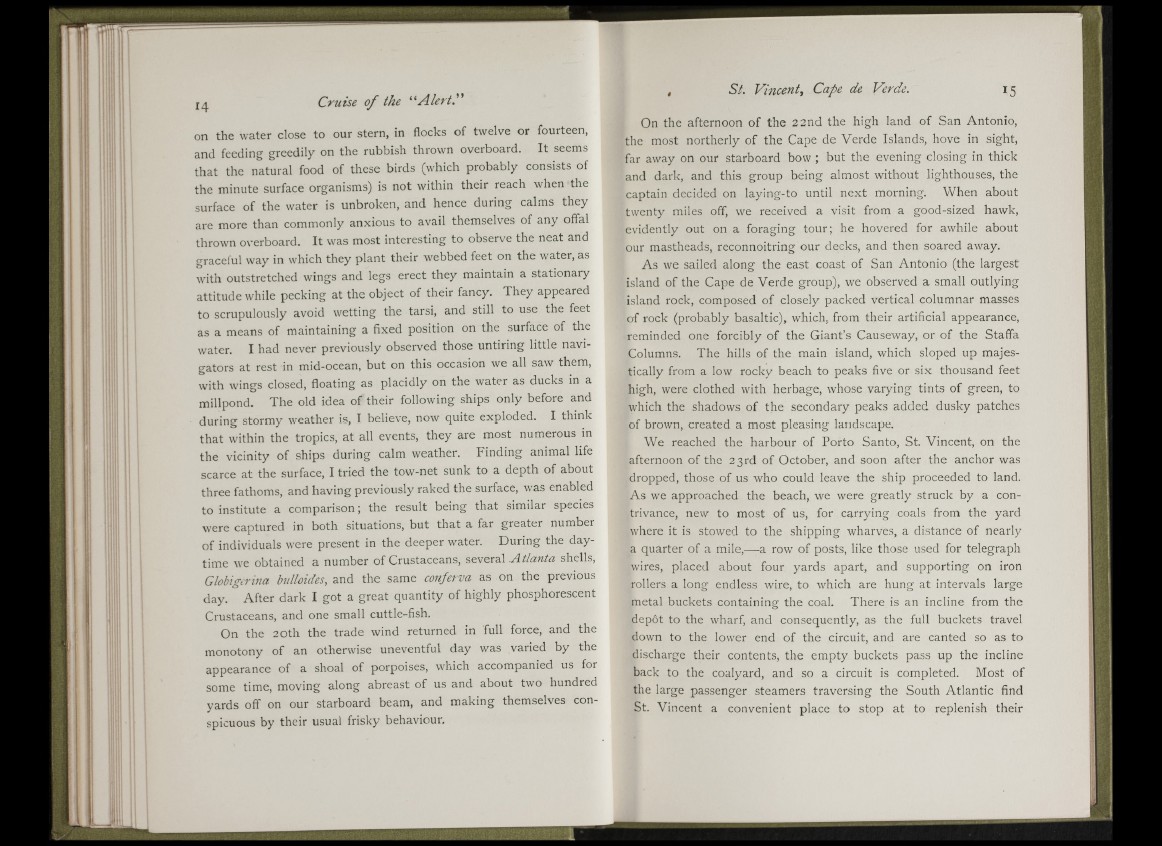
ii ! :
F
til
14 Cruise o f the “ Alert.”
on the water close to our stern, in flocks of twelve or fourteen,
and feeding greedily on the rubbish thrown overboard. It seems
that the natural food of these birds (which probably consists of
the minute surface organisms) is not within their reach when the
surface of the water is unbroken, and hence during calms they
are more than commonly anxious to avail themselves of any offal
thrown overboard. It was most interesting to observe the neat and
graceful way in which they plant their webbed feet on the water, as
with outstretched wings and legs erect they maintain a stationary
attitude while pecking at the object of their fancy. They appeared
to scrupulously avoid wetting the tarsi, and still to use the feet
as a means of maintaining a fixed position on the surface of the
water. I had never previously observed those untiring little navigators
at rest in mid-ocean, but on this occasion we all saw them,
with wings closed, floating as placidly on the water as ducks in a
millpond. The old idea of their following ships only before and
during stormy weather is, I believe, now quite exploded. I think
that within the tropics, at all events, they are most numerous in
the vicinity of ships during calm weather. Finding animal life
scarce at the surface, I tried the tow-net sunk to a depth of about
three fathoms, and having previously raked the surface, was enabled
to institute a comparison; the result being that similar species
were captured in both situations, but that a far greater number
of individuals were present in the deeper water. During the daytime
we obtained a number of Crustaceans, several Atlanta shells,
Globigerina bulloides, and the same conferva as on the previous
day. After dark I got a great quantity of highly phosphorescent
Crustaceans, and one small cuttle-fish.
On the 20th the trade wind returned in full force, and the
monotony of an otherwise uneventful day was varied by the
appearance of a shoal of porpoises, which accompanied us for
some time, moving along abreast of us and about two hundred
yards off on our starboard beam, and making themselves conspicuous
by their usual frisky behaviour.
St. Vincent, Cape de Verde. 15
On the afternoon of the 22nd the high land of San Antonio,
the most northerly of the Cape de Verde Island.s, hove in sight,
far away on our starboard bow ; but the evening closing in thick
and dark, and this group being almost without lighthouses, the
captain decided on laying-to until next morning. When about
twenty miles off, we received a visit from a good-sized hawk,
evidently out on a foraging tour; he hovered for awhile about
our mastheads, reconnoitring our decks, and then soared away.
As we sailed along the east coast of San Antonio (the largest
i.sland of the Cape de Verde group), we observed a small outlying
island rock, composed of closely packed vertical columnar masses
of rock (probably basaltic), which, from their artificial appearance,
reminded one forcibly of the Giant’s Causeway, or of the Staffa
Columns. The hills of the main island, which sloped up majestically
from a low rocky beach to peaks five or six thousand feet
high, were clothed with herbage, whose varying tints of green, to
which the shadows of the secondary peaks added dusky patches
of brown, created a most pleasing landscape.
We reached the harbour of Porto Santo, St. Vincent, on the
afternoon of the 23 rd of October, and soon after the anchor was
dropped, those of us who could leave the ship proceeded to land.
As we approached the beach, we were greatly struck by a contrivance,
new to most of us, for carrying coals from the yard
where it is stowed to the shipping wharves, a distance of nearly
a quarter of a mile,— -a row of posts, like those used for telegraph
wires, placed about four yards apart, and supporting on iron
rollers a long endless wire, to which are hung at intervals large
metal buckets containing the coal. There is an incline from the
depot to the wharf, and consequently, as the full buckets travel
down to the lower end of the circuit, and are canted so as to
discharge their contents, the empty buckets pass up the incline
back to the coalyard, and so a circuit is completed. Most of
the large passenger steamers traversing the South Atlantic find
St. Vincent a convenient place to stop at to replenish their
1^1
mi
IS
■A) ]
m\